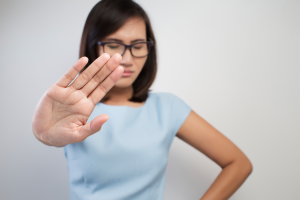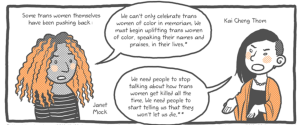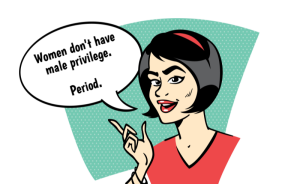
A person sits on a couch holding a glass in one hand, and the other hand to their forehead. They appear tired.
I have a confession. I love sitcoms.
Television watching is a favorite pastime for folks around the world, and as much I can briefly enjoy the high-intensity dramas many of my peers engage with, I find they often become overwhelming and ultimately operate to stress me out when I mean to relax. The lightness of sitcoms allows me to unwind and participate in this pastime without sacrificing my peace of mind.
But sitcom-watching can become frustrating when having to navigate the complicated experience of acknowledging the sadly inevitable racism, anti-Blackness, misogyny, transmisogyny, ableism, fat hatred, and other forms of dehumanization and subjugation. Our culture has attempted to convince us that this is what humor and entertainment look like, and it can be hard to extract joy and humor in television’s other aspects.
Critical television engagement remains an important aspect of my personal-political practice, and my inclinations are, of course, colored by my own positionality as a fat, queer, femme of color. This means that I still gravitate towards shows that feature people of color, fat people, queers, and femmes in my curation – and why shows like The Mindy Project and The Unbreakable Kimmy Schmidt, for example, remain important to me.
Despite their (many, many) shortcomings, outside of Mindy Lahiri and Titus Andromedon, there are so few other places I could see a fat femme of color portrayed at all, but much less as a legitimate love interest. I value that.
So while there’s clearly some forward momentum toward showing fat people to be fully realized, three-dimensional characters, I still yearn for a character whose fatness is part of them.
Where Mindy Lahiri, Titus Andromedon, and even Parks and Recreation’s Donna Meagle are fat characters shown as successful, funny, insecure, talented, loved, and flawed, their body size is rarely, if ever, mentioned – and certainly not as a positive or even neutral aspect of them.
Some might argue that a politicized fat or fat positive character might initially seem far-fetched or even, perhaps, entitled or greedy. However, there appears to be a vast gulf in contrast to the space and attention given to the post-fat character trope, where fatness is repeatedly referenced but rarely present, and fat characters who and embrace their fatness as a positive attribute.
The post-fat character was once fat, usually in their youth, but made radical changes (which are never, ever explored in detail) in their early adulthood, resulting in a thinner body and a different person.
And this body is, apparently, now worthy of gracing our television sets (or computer screens) – unlike their previous, and many current, fat bodies.
The most obvious example of this is of classic ‘90s sitcom Friends’ Monica, played by Courtney Cox-Arquette, which has been examined rather extensively by fat activists. I have seen the same trope replicated in Monica’s contemporary of Third Rock from the Sun’s Dr. Mary Albright, played by Jane Curtin, and, more recently, New Girl’s Schmidt, played by Max Greenfield. And I’m sure that there are many more that I’m missing.
But this trope speaks volumes about our culture’s value of fatness. Here are some ways this trope illuminates how we’re being conditioned to see fat bodies, and how these things are actually actively harming not only fat people, but all of our relationships to our bodies.
1. It Keeps Fatness in the Cultural Imagination – Without Fat Bodies
The mythology of the post-fat character allows writers to continuously bring fatness into the conversation – but only as a punchline, without any visibility or justice for actual fat people. They allow the characters to deliver purportedly in-group jokes about fatness, where the presumably thin audience is allowed an insider look at the psychology of fat people.
This blurs the lines of what is acceptable to say amongst fat peers and what can safely and comfortably be talked about in front of thin onlookers, giving any thin audience a false sense of security that they’re laughing with us when they are actually laughing at us.
This is especially disheartening when as one can only assume that these jokes are written by people who are not (and have never been) fat, or people who don’t want to be fat if they are.
This tactic reifies the ideology that: 1) thin bodies attainable for everyone, 2) we’re all supposed to want to have thin bodies if we don’t already and, 3) in the process of this desire for thin bodies, we’re meant to actively hate fat bodies, even if we don’t want thin bodies and/or have fat bodies.
This is the logic that allows daily and common microaggressions against fat people: the experience of people bemoaning the calories in what they’re eating, when they moralize food intake (like “I’m being ‘bad’ by eating this treat”), when they say they’re “feeling” fat, when they shame what others are eating, and so on.
This frequently happens in the presence of actual fat people without any consideration to how this is upholding a culture that harms us by perpetuating the expectation that no one should be fat – and that if we are, we should understand that we shouldn’t be and should be making active attempts to minimize our fatness at all cost.
The expectation of an understanding that we’re supposed to hate our fat bodies – and therefore should agree with these statements – is an extension of this false representation.
With the post-fat character, fatness is allowed to constantly be present without fat people ever being seen, being sympathetic, or being fully realized human beings.
2. It Acts as a Substitute for Actual Fat Bodies
Jokes about fatness from non-fat characters bring fatness into the mind of the viewer, but substitute the materiality of actual fat bodies.
Even on Parks and Recreation, where a prominent running joke is that the city of Pawnee, Indiana has the highest population of fat people than anywhere else in the US, there are rarely any fat townspeople shown, even with multiple opportunities during another recurring joke of town hall meetings.
Further, when actual fat people are represented with the characters Donna and Jerry, they often fall short of being fully realized, multifaceted characters with goals, hopes, wishes, dreams, disappointments, loves or losses, and repeatedly get reduced to embodied fat stereotypes. Jerry, for example, actualizes the bumbling, unintelligent, and incompetent fat subject—the manifestation of the sentiments that fat people are fat because we are too stupid to take care of ourselves.
And while Donna certainly challenges some fat stereotypes, her characterization doesn’t feel enough to counter the show’s larger portrayal of fatness and, in many ways, demonstrates the ways in which thin people have fat people in their lives they may love and respect, while simultaneously holding fat-biased views.
While mere visibility and representation won’t be enough to completely change culture or provide justice and liberation for fat people, this mirror is vital for both fat and thin people to confront – and ultimately change our notions of and attitudes toward fatness.
Seeing honest portrayals of what fat bodies look like through videos, photographs, and even my own mirror was vital in learning to accept my own.
Television isn’t the only – or even a necessary – platform for this mirror, but this substitution stifles this possibility in order to continue facilitating the cycle of hating fat bodies, even if they’re our own.
3. It Reinforces the Myth that Significant Weight Loss Is Sustainable
It is a well-documented and long talked-about aspect of fat liberation that most bodies have a set weight that may change some with diet or exercise, but this set weight will leave a body more or less as-is.
While long-term weight loss is technically possible, studies have shown that dieting does not work and that over 97% of people who lose fifty pounds or more gain that weight back (plus some) within three years.
Characters like Friends’ Monica and New Girl’s Schmidt underwent rapid weight loss as adults – seemingly within five years of when their newly thin or muscular characters’ arc begins on the shows – and maintained their primetime-ready thin, white bodies.
But somehow, they managed to do this without stretch marks, loose skin, increased likelihood to gain back any weight at all, or any other reality of varying body size. This goes against what is known about fatness, and especially most people who attempt to drastically decrease their body size.
This trope teaches both fat and thin viewers that fatness can and therefore should be changed, that it is a choice (which, of course, sometimes, it is), and that it’s the wrong one.
It’s true that a certain level of suspension of disbelief is required for any enjoyable engagement in popular culture, and the expectation of a realistic portrayal of almost any storyline is a long-lost pipe dream for most marginalized people. But this is one narrative that actively works to maintain a harmful and unrealistic expectation of bodies. It feeds the billion-dollar weight loss and beauty industry, where vulturesque millionaires profit off of exploiting the insecurities of primarily women, femmes, and queer men.
These characters’ weight-loss stories encourage us to internalize limiting fat shaming and biased ideas about the possibilities of what a body can (and should) be. They manipulate fat people into longing for unsustainable goals, rather than facilitating self-love and acceptance of all bodies.
4. It Endorses the Myth that Fat People’s Lives Don’t Begin Until We Lose Weight
This is sold to us constantly.
It’s a myth based on the aforementioned falsehood that thin bodies are possible for everyone, that everyone should want one, and that fat people’s inability to attain a thin body is a reflection of our lack of discipline and motivation.
It’s peddled to convince fat people that we are (or should be) miserable with ourselves and our lives, and once we’ve successfully conformed to the societal pressures of acceptable bodies, everything in our lives will begin to go right.
These myths engineer insecurities in us to exploit through an endless cycle of weight-loss products that inevitably don’t work; over-priced, low-quality clothing; and low wages.
These ideologies are tied to capitalist and monogamist values, as the two biggest myths we’re sold is that our careers will advance and we will find more (and/or better) lovers as thin people. These systems are not only related, but dependent on each other. The presumption is that fatness is the product of unproductivity, as well as resulting in being prone to early death. Therefore, it’s believed that fat people are not beneficial to capitalism as highly productive or long-term workers. And this has encouraged capitalism to target women and femmes.
Sadly, there is some truth to this. Wage discrimination, especially for fat women, is well-documented. The difficulties of dating as a fat woman and/or femme is a very pressing conversation currently, and something I’ve even written about before.
These are issues with very real material consequences for the fat folks they affect and absolutely deserve time and attention. But they will also not necessarily be resolved with weight loss – they demand systemic attention, rather than an individualistic approach.
By writing stories for people only after they’ve lost weight, television shows are subtly demonstrating this – for, in the world of television, a characters life literally begins with the series.
While they may have past experiences (including as a fat person), those experiences were merely precursors to their true stories that happen as the show airs. Fat people are living full lives that are complicated, and happy, and difficult, and full of struggles, and successes, and failures.
We are fully realized at our current, and past, and future sizes, and, if we can not have that reflected back at us, we, at the very least, deserve to not be the vehicle for jokes in a media that indoctrinates us all into standards that harm us physically and mentally.
***
This is by no means a comprehensive analysis of every fat character on a sitcom – nor is it meant to be. There may be fat characters I overlooked that challenge or disprove some of these cultural myths. If so, that’s incredible, and I welcome and celebrate it.
However, these tropes are reflecting and shaping our understanding of fatness on a structural level, and individual characters cannot (and do not) compensate for or challenge larger narratives that the post-fat character perpetuates.
While television, and especially sitcoms, might seem like a rather trivial location for this critique, feminist scholarship has taught us that the art we create (and, yes, even sitcoms) can tell us much about the world around us and the world we wish to build.
These tropes exist in a culture that encourages fat people to harm ourselves to change our bodies and punishes us when we don’t. This punishment appears most obviously under the Medical Industrial Complex, through negligent medical care that links any ailments to fatness (even if fatness is, perhaps, a result of illness).
This results in a cultural discouragement to even seek medical care as a fat person, potentially contributing to higher mortality rates that are often decontextualized and linked solely to body size.
When we can move away from these tropes, we can improve the lives of everyone by creating better conditions not just for fat people, but environments that allow everyone to have healthier relationships to our bodies and its inevitable changes. And ultimately, our lives will improve at any size when we’re afforded the same love, value, respect, and autonomy given freely to thin folks.
In the meantime, I just want to laugh as much as possible.
[do_widget id=’text-101′]
Caleb Luna is a working class fat, brown, queer, living, writing, performing and dancing in Oakland, California. They are a first-year Ph.D. student at University of California, Berkeley, and their work explores the intersections of fatness, desire, fetishism, white supremacy and colonialism from a queer of color lens. You can find more of their writing on Black Girl Dangerous and on Facebook and Tumblr under queerandpresentdanger.
Search our 3000+ articles!
Read our articles about:
Our online racial justice training
Used by hundreds of universities, non-profits, and businesses.
Click to learn more




















